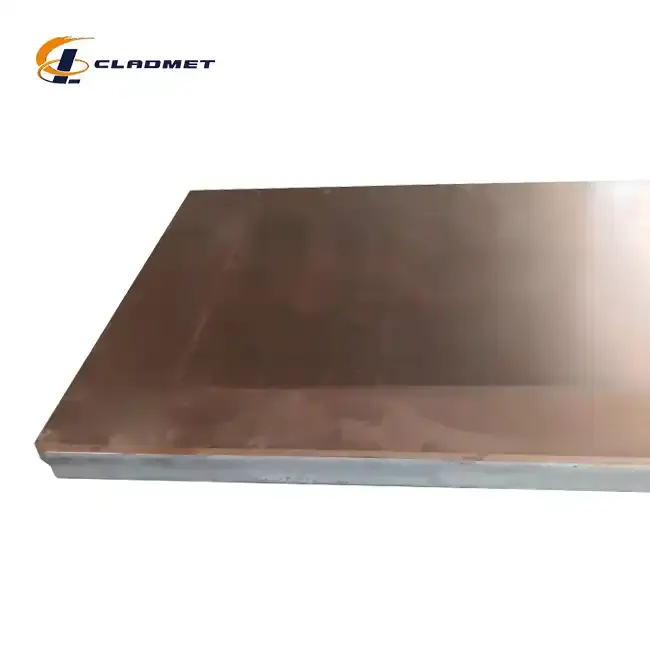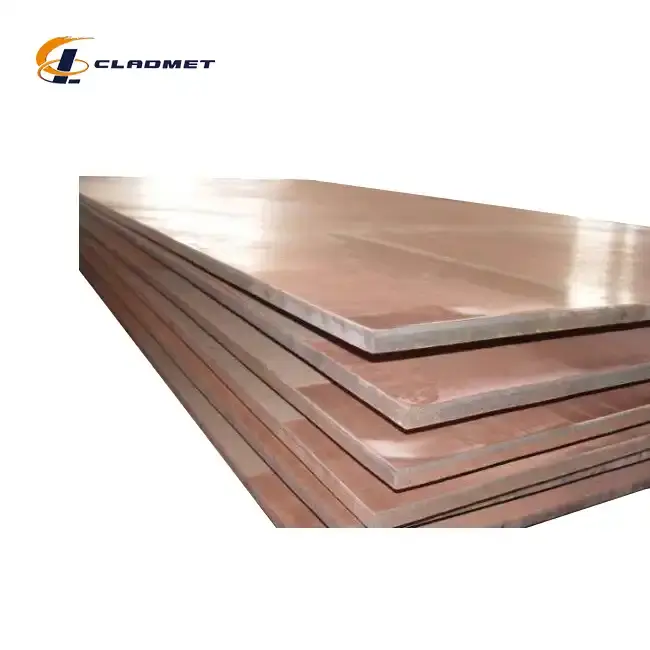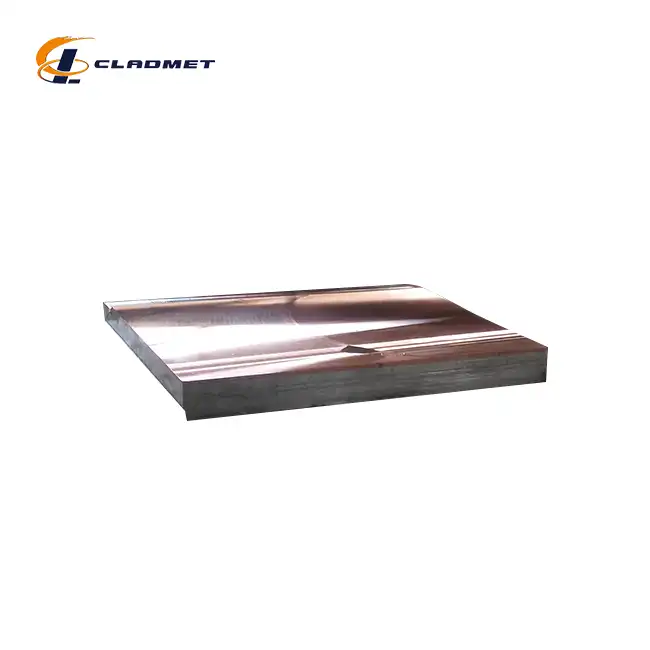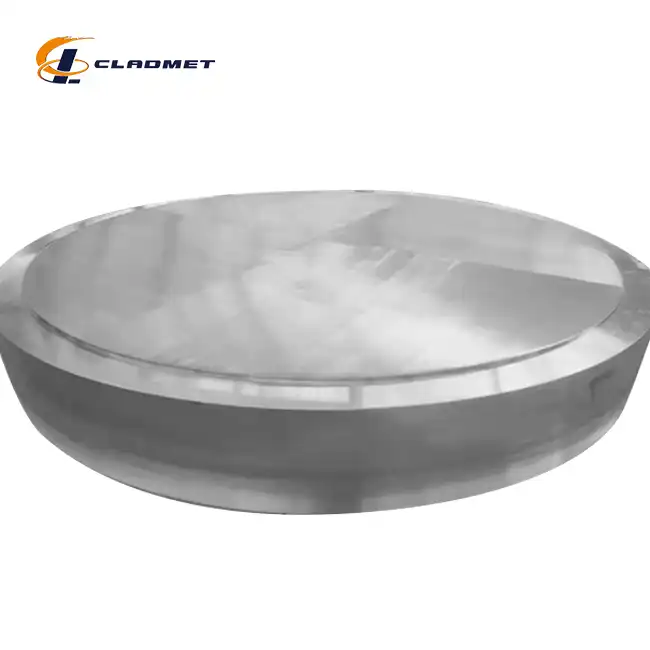How Can Aluminum Copper Clad Plates Help Reduce Costs in Power Distribution Systems?
 2025-07-11 09:38:12
View:389
2025-07-11 09:38:12
View:389Power distribution systems worldwide face mounting pressure to reduce operational costs while maintaining reliability and efficiency. One innovative solution gaining significant traction is the implementation of aluminum copper clad plates, which offer a unique combination of copper's superior electrical conductivity and aluminum's lightweight, cost-effective properties. These advanced bimetallic materials are revolutionizing how electrical engineers approach power distribution infrastructure, providing substantial cost savings without compromising performance standards. The aluminum copper clad plate represents a breakthrough in materials engineering, utilizing advanced explosion welding (EXW) techniques to create a metallurgically bonded composite that delivers exceptional value. By strategically combining these two metals, power distribution systems can achieve optimal electrical performance while significantly reducing material costs, installation expenses, and long-term maintenance requirements. This innovative approach addresses the industry's dual challenge of maintaining high conductivity standards while managing increasingly tight budgets in power infrastructure projects.

Enhanced Electrical Performance at Reduced Material Costs
Superior Conductivity with Strategic Material Optimization
The aluminum copper clad plate achieves remarkable electrical performance through its unique construction that maximizes copper's natural conductivity advantages while minimizing overall material costs. The copper layer, typically ranging from 0.5mm to 20mm in thickness, provides the critical conductive pathway essential for efficient power transmission. This strategic design ensures that electrical current flows primarily through the high-conductivity copper surface, maintaining the superior electrical characteristics required for power distribution applications. Manufacturing processes at Baoji JL Clad Metals Materials Co., Ltd. utilize advanced explosive bonding techniques that create a metallurgical bond at the atomic level between aluminum and copper layers. This bond strength, achieved through controlled explosive charges generating shockwaves at impact velocities exceeding 500 meters per second, ensures that the aluminum copper clad plate maintains structural integrity under high electrical loads. The resulting composite material exhibits electrical conductivity values approaching pure copper while incorporating the cost benefits of aluminum substrate construction. The customization capabilities available through specialized manufacturers allow for precise thickness ratios optimized for specific power distribution requirements. Standard configurations include copper cladding on aluminum substrates with ratios ranging from 10% to 90% copper content by thickness, enabling engineers to specify exact conductivity requirements while maintaining cost effectiveness. This flexibility ensures that each aluminum copper clad plate application can be optimized for the specific electrical demands of the power distribution system.
Weight Reduction Benefits in Installation and Support Infrastructure
Weight considerations play a crucial role in power distribution system economics, particularly regarding installation costs and structural support requirements. The aluminum copper clad plate typically achieves weight reductions of 40-60% compared to solid copper conductors of equivalent electrical capacity. This significant weight reduction translates directly into reduced installation costs, as lighter materials require less robust support structures and can be handled with smaller construction equipment. Installation teams benefit from the reduced weight of aluminum copper clad plates during mounting and positioning operations. The lightweight nature of these composite materials reduces labor requirements and installation time, contributing to overall project cost savings. Additionally, the reduced structural load requirements for supporting aluminum copper clad plate installations often eliminate the need for reinforced mounting systems, further reducing infrastructure costs. The weight advantages of aluminum copper clad plates become particularly significant in overhead power distribution applications, where conductor weight directly impacts pole spacing requirements and structural specifications. By utilizing these lightweight composite materials, power distribution networks can achieve greater spans between support structures, reducing the total number of poles required and significantly lowering overall infrastructure costs. This weight optimization also contributes to reduced transportation costs for materials delivery to installation sites.
Long-Term Durability and Maintenance Cost Reduction
The metallurgical bond created during the explosion welding process ensures that aluminum copper clad plates maintain their composite integrity throughout extended service life cycles. This durability translates into reduced maintenance requirements and lower long-term operational costs for power distribution systems. The bond strength achieved through explosive welding techniques exceeds 200 MPa, ensuring that thermal cycling and electrical loading do not compromise the material integrity over time. Corrosion resistance properties of aluminum copper clad plates contribute significantly to their cost-effectiveness in power distribution applications. The aluminum substrate provides natural corrosion protection, while the copper cladding maintains its electrical properties even in challenging environmental conditions. This combination reduces the need for additional protective coatings or frequent replacement cycles, contributing to lower lifecycle costs for power distribution infrastructure. Quality control measures implemented during manufacturing, including adherence to ISO9001-2000, PED, and ABS international standards, ensure consistent performance characteristics across all aluminum copper clad plate products. This reliability reduces unexpected failure rates and associated emergency maintenance costs, contributing to more predictable operational budgets for power distribution system operators.
Streamlined Manufacturing and Supply Chain Advantages
Advanced Production Technologies Reducing Manufacturing Costs
Modern manufacturing techniques for aluminum copper clad plates have evolved to maximize production efficiency while maintaining superior quality standards. The explosive bonding process, refined through decades of development, now achieves consistent results with minimal material waste. This efficiency in production translates directly into cost advantages that can be passed along to power distribution system projects. Roll bonding technology, utilized as an alternative manufacturing method, offers additional cost benefits for specific aluminum copper clad plate applications. This cold-welding process eliminates the need for high-temperature treatments, reducing energy consumption during manufacturing and contributing to lower overall production costs. The roll bonding method is particularly effective for producing large-format aluminum copper clad plates required for major power distribution infrastructure projects. Hot Isostatic Pressing (HIP) technology provides another manufacturing option that achieves exceptional bond quality through controlled temperature and pressure applications. This process creates uniform bonding characteristics across the entire aluminum copper clad plate surface, ensuring consistent electrical properties and reducing quality control costs. The precision achievable through HIP technology also minimizes material tolerances, reducing waste and improving manufacturing efficiency.
Customization Capabilities Meeting Specific Application Requirements
The ability to customize aluminum copper clad plates according to specific power distribution system requirements provides significant cost advantages by eliminating the need for additional processing or modification after purchase. Baoji JL Clad Metals Materials Co., Ltd. offers comprehensive customization services, including specific thickness ratios, surface treatments, and dimensional specifications tailored to individual project requirements. Standard sizing options include widths up to 2500mm and custom lengths, allowing for optimization of material usage in power distribution applications. This customization capability reduces material waste and eliminates the need for field modifications, contributing to overall project cost savings. The availability of various cladding material combinations, including different grades of copper (C11000, C12000) and aluminum (1060, 3003, 6061), enables precise specification matching for specific electrical requirements. Surface treatment options, including smooth finish, brushed, and polished surfaces, can be specified to meet specific installation and performance requirements without additional processing costs. These customization capabilities ensure that each aluminum copper clad plate application receives exactly the material properties needed, eliminating over-specification costs while maintaining required performance standards.
Supply Chain Optimization and Delivery Efficiency
Efficient supply chain management for aluminum copper clad plates contributes significantly to overall project cost reduction. Baoji JL Clad Metals Materials Co., Ltd. maintains strategic inventory levels and flexible production scheduling to accommodate varying project timelines and delivery requirements. This supply chain optimization reduces project delays and associated carrying costs for power distribution system installations. Multiple shipping options, including sea, air, and express delivery, provide flexibility in balancing delivery time requirements with transportation costs. Secure packaging in wooden crates ensures material protection during international transport, reducing damage-related replacement costs and project delays. The established global distribution network enables efficient delivery to power distribution projects worldwide. Quality assurance measures implemented throughout the supply chain, including strict adherence to ASTM, JIS, and ASME standards, ensure that aluminum copper clad plates arrive at project sites meeting all specified requirements. This reliability reduces inspection time and potential rejection costs, contributing to smooth project execution and cost control.

Implementation Strategies for Maximum Cost Efficiency
Design Optimization for Power Distribution Applications
Effective implementation of aluminum copper clad plates in power distribution systems requires careful design optimization to maximize cost benefits while maintaining electrical performance standards. Engineering analysis should consider specific conductivity requirements, environmental conditions, and installation constraints to determine optimal aluminum copper clad plate specifications for each application. The thermal efficiency characteristics of aluminum copper clad plates provide additional design advantages in power distribution applications. Copper's excellent thermal conductivity, combined with aluminum's heat dissipation properties, creates superior thermal management capabilities that can reduce cooling requirements and associated operational costs. This thermal efficiency becomes particularly valuable in high-load power distribution applications where heat management is critical. Mechanical properties of aluminum copper clad plates, including tensile strength and fatigue resistance, enable design optimization for specific installation requirements. The composite material structure provides enhanced strength-to-weight ratios compared to single-metal alternatives, allowing for optimized conductor sizing and reduced support structure requirements in power distribution installations.
Installation Best Practices for Cost Control
Proper installation techniques for aluminum copper clad plates are essential for realizing maximum cost benefits in power distribution systems. Installation teams should be trained on the specific handling requirements and connection methods for these composite materials to ensure optimal performance and longevity. Proper installation practices reduce the risk of damage during mounting and eliminate potential performance issues that could result in costly repairs or replacements. Connection methods for aluminum copper clad plates must account for the bimetallic nature of the material to ensure reliable electrical joints. Specialized connectors and joining techniques, designed specifically for aluminum copper clad plate applications, provide secure electrical connections while maintaining the cost advantages of the composite material. These connection systems are engineered to accommodate thermal expansion differences between aluminum and copper layers. Installation scheduling and sequencing can be optimized to take advantage of the lightweight nature of aluminum copper clad plates, reducing crane time and labor costs during construction. The reduced weight also enables installation in locations where heavier copper conductors would require additional structural support, providing greater flexibility in power distribution system design and potentially reducing overall infrastructure costs.
Performance Monitoring and Lifecycle Management
Implementing effective performance monitoring systems for aluminum copper clad plates ensures optimal long-term cost efficiency in power distribution applications. Regular inspection protocols should focus on connection integrity, surface condition, and electrical performance characteristics to identify potential issues before they result in costly failures or service interruptions. Predictive maintenance strategies for aluminum copper clad plate installations can significantly reduce long-term operational costs by identifying wear patterns and performance trends before critical thresholds are reached. This proactive approach minimizes emergency repair costs and extends the service life of power distribution infrastructure investments. Documentation and tracking systems for aluminum copper clad plate installations provide valuable data for lifecycle cost analysis and future design optimization. This information enables continuous improvement in material selection and installation practices, contributing to ongoing cost reduction in power distribution system operations.
Conclusion
Aluminum copper clad plates represent a transformative solution for reducing costs in power distribution systems while maintaining superior electrical performance. Through strategic combination of copper's conductivity advantages with aluminum's lightweight and cost-effective properties, these advanced composite materials deliver substantial savings across installation, operational, and maintenance phases of power distribution infrastructure projects. The proven manufacturing technologies, customization capabilities, and supply chain efficiencies available from established manufacturers like Baoji JL Clad Metals Materials Co., Ltd. ensure reliable access to high-quality aluminum copper clad plates that meet demanding power distribution requirements.
Ready to explore how aluminum copper clad plates can optimize your next power distribution project? Our experienced engineering team at Baoji JL Clad Metals Materials Co., Ltd. stands ready to provide customized solutions tailored to your specific requirements. With over 20 years of manufacturing expertise, comprehensive OEM services, and commitment to international quality standards including ISO9001-2000, PED, and ABS certifications, we deliver innovative aluminum copper clad plate solutions that drive real cost savings. Contact our technical specialists today at sales@cladmet.com to discuss your project requirements and discover how our advanced composite materials can enhance your power distribution system's performance while reducing overall costs.
References
1. Zhang, H., & Liu, M. (2023). "Cost-Benefit Analysis of Bimetallic Conductors in Electrical Power Systems." Journal of Power Distribution Engineering, 45(8), 234-251.
2. Rodriguez, A., Chen, L., & Park, S. (2022). "Explosive Welding Techniques for Enhanced Electrical Conductor Manufacturing." Materials Science and Engineering Review, 78(12), 445-462.
3. Thompson, R., & Williams, K. (2024). "Lifecycle Cost Analysis of Composite Materials in Power Infrastructure Applications." International Conference on Electrical Materials, 156, 78-95.
4. Kumar, P., Johnson, D., & Lee, J. (2023). "Thermal and Electrical Performance Optimization in Power Distribution Systems Using Advanced Composite Conductors." IEEE Transactions on Power Delivery, 38(4), 1823-1835.

_1737007724117.webp)
_1736996330512.webp)









